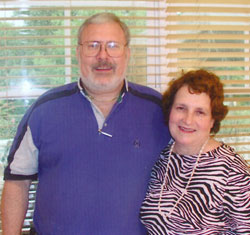Ed Chidakel
by Susan Chidakel
So many people asked me the question, “What’s wrong with Ed,” that I could no longer ignore my nagging concerns – we needed to know what was really wrong. For a long time, my husband’s diagnoses didn’t seem quite right. In January of 2005, a neurologist diagnosed Ed with Parkinson’s disease at the mere age of 55. After a year of receiving treatments that yielded no results, we happened to attend a presentation on Parkinson’s disease at Georgetown University, where we found out about the variants. We learned about PSP and recognized that those symptoms were the ones that Ed had been experiencing. The speaker told us we could learn more by going to the CurePSP website. That was where we found out what the future had in store for us. Later, our neurologist confirmed the PSP diagnosis.
Ed was able to work for only another 2 years. By that point, he’d been falling frequently, was no longer driving, and speech was becoming more difficult. Ed had already had swallowing issues and we were using thickener in his liquids. Soon after Ed quit working, we had a consultation with a specialist who confirmed that there was no cure or treatment – all we could do was keep him safe. Ed started using a walker after that – our goal was for him to not fall.
We took our final real vacation to Hawaii that year. It was a cruise around the Hawaiian islands, leaving from Oahu and then extending on the island for a few extra days. Ed was still functioning enough for us to do some bus excursions and, with the help of a wheelchair, we pulled it off. It was a lot of work on my part, but Ed enjoyed it so much; it was really worth it all.
In 2008, our son left for a 2 year commitment in Africa with the Peace Corps. We were eager for him to continue with his life’s aspirations and only hoped that he would be able to complete his time there. Back at home, Ed encountered more setbacks. In May, he fell and fractured a bone in his cheek – my our first 911 call. It healed without surgery but we were on the alert. Ed was provided with rehab services and we were told how to make adjustments to our house, making it safer for him. We stopped sleeping upstairs. Ed slept in a lift chair in the family room while I spent my nights on the couch. We’d only go upstairs once a week for a complete shower; otherwise it was sponge baths in the powder room.
July of that year brought another fall resulting in a broken bone in Ed’s hand and a subsequent cast for 6 weeks. At that time, we enrolled him in the county-run adult day care program, which he attended 3 days a week. Amazingly, he loved going there, but his participation in the program only lasted 7 months. Ed’s needs had grown too large with feeding taking hours to complete – the county wasn’t staffed for that. We enrolled him in another day care program at a nearby nursing home. A feeding tube was then put in, followed by a 3 week stay at a rehabilitation center. When Ed came home from that procedure, we hired an aide to help out 2 days a week, and also had nursing home day care for 2 days a week. I was working full time for a most understanding employer, just half a mile from home and fortunately, was able to do some work at home.
In December of 2009, Ed suffered a throat infection and was kept in the ICU for 10 days. He had to undergo a tracheostomy, which hospitalized him for another 3 weeks. Ed then went to another rehab for about a month. However, he was able to get that removed before he came home. For the next 13 months, we had him home with our aide coming 3 days a week, me working at home or going back and forth 2 days a week, and support from hospice, family, and good friends. I cannot say enough about how valuable the help from hospice was with his care.
In March of 2011, hospice had scheduled a respite stay for Ed at their inpatient facility to give me a short break. I was relieved that he was going to be there since that week had been particularly difficult for him and his need for suctioning was becoming more constant. However, at hospice we were told that his feedings, as limited as they were, were not digesting and suctioning was not helping. The doctor suggested that the time had come to end the feedings. After much resistance by both my son and I, we were forced to face the inevitable, and stopped the feedings. Four days later, Ed finally succumbed. He had already stopped being responsive beforehand, so I do believe that the ending was peaceful for him.
My husband had always had the most positive outlook on life with a tremendous amount of patience and perseverance – I believe that’s why he lived with the disease for so long. When he received his diagnosis, he dealt with it in the most positive manner possible for him, which was contrary in many ways to the stubborn ‘can do’ way he had always lived his life. He never complained, always remained positive, and continued to laugh at silly things happening around him. Our son came home, stepped up, and cared for the person who always had cared for him. That was an amazing transformation for me to see and possibly the most positive aspect of this ordeal.
We will always treasure and miss our beloved Ed.
